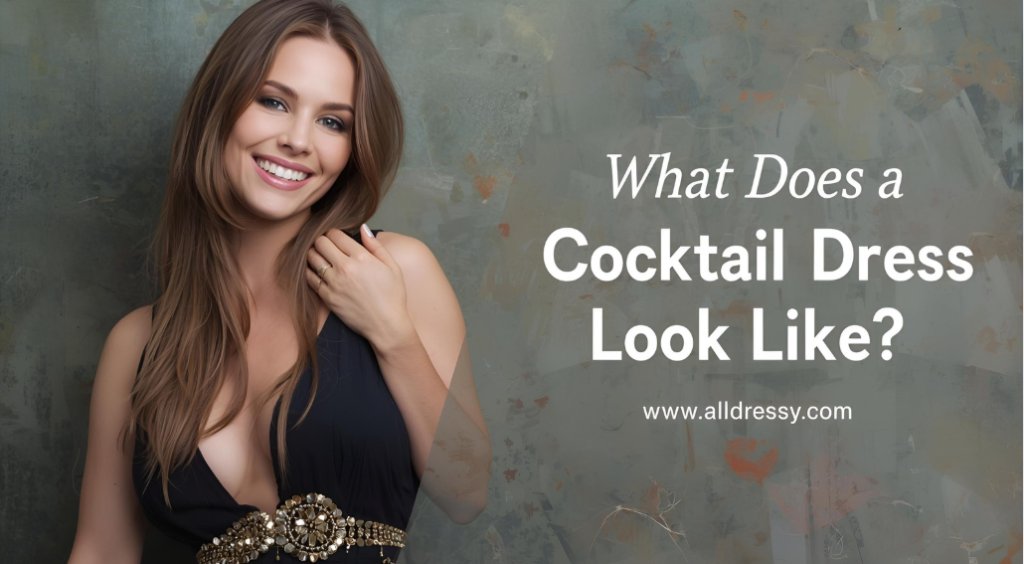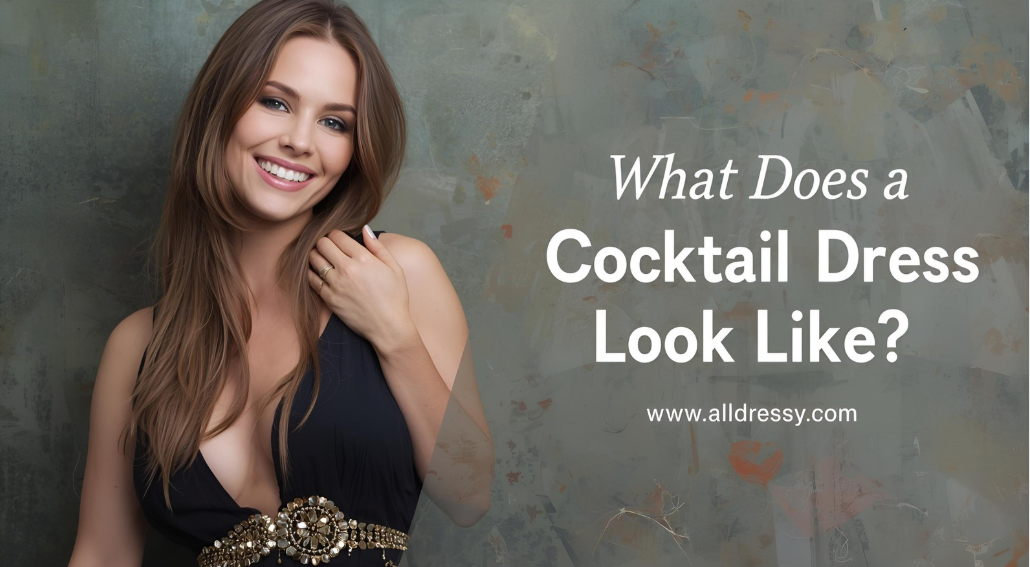You’ve received an invitation for a wedding, a gala, or an upscale party, and the dress code clearly states “Cocktail Attire.” This simple phrase can trigger a wave of sartorial anxiety, leading to the fundamental question: what does a cocktail dress look like? While the term may seem broad, it actually refers to a specific and versatile category of evening wear that sits perfectly between casual daywear and formal full-length gowns. Understanding the nuances of this dress code is key to looking appropriately chic and feeling confident for your event.
This comprehensive guide is designed to be your ultimate resource, demystifying the cocktail dress in all its forms. We will dissect the key elements—length, silhouette, fabric, and color—that define this classic style. Beyond just answering what does a cocktail dress look like, we will explore its various interpretations, from timeless little black dresses to modern jumpsuit alternatives. Whether you’re attending a semi-formal evening wedding, a holiday party, or a sophisticated birthday celebration, this article will equip you with the knowledge to choose a dress that is both stunning and perfectly suited to the occasion. Let’s unravel the elegance and excitement of cocktail dressing.
The Origin and Evolution of the Cocktail Dress

To fully understand the modern cocktail dress, it’s helpful to glance at its history. The term “cocktail dress” emerged in the 1920s, during the Prohibition era in the United States. As social drinking moved to underground “speakeasies,” women needed attire that was more refined than daywear but less formal than the elaborate gowns worn at opera or grand balls.
Designer Coco Chanel is often credited with pioneering the early cocktail dress. She introduced simple, elegant dresses that were shorter than evening gowns, allowing for ease of movement and a modern, liberated silhouette. The style truly flourished in the post-World War II 1950s, with Christian Dior’s “New Look” emphasizing cinched waists, full skirts, and an overtly feminine aesthetic. This established the cocktail dress as a symbol of post-war optimism and chic sophistication.
Today, the cocktail dress has evolved to encompass a wide range of styles, but its core purpose remains: to provide an elegant, polished, and festive look for semi-formal social gatherings that typically occur in the late afternoon or evening.
The Defining Characteristics: What Does a Cocktail Dress Look Like?
While there is room for personal expression, a classic cocktail dress adheres to several key style principles that distinguish it from other types of dresses.
The Golden Rule: Length
The most consistent and defining feature of a cocktail dress is its length. Traditionally, a cocktail dress is knee-length. However, the modern interpretation offers more flexibility.
- Knee-Length: The safest and most classic option. The hemline should hit anywhere from just above the knee to just below the knee.
- Tea-Length: Falling between the knee and the ankle, this length is elegant and vintage-inspired, often suitable for more conservative or formal cocktail events.
- Mini-Length: A shorter, above-the-knee dress can be acceptable for a trendy, modern cocktail party, especially for younger attendees or in a more fashion-forward setting. The key is to balance a shorter length with a more sophisticated fabric and design to avoid looking too casual.
What to generally avoid for a classic cocktail dress: full-length formal gowns and casual daytime sundresses.
Silhouette and Style: Finding Your Fit
The silhouette of your dress is where you can express your personal style. There are several classic and flattering cuts to consider.
1. The Little Black Dress (LBD):
The quintessential cocktail dress. It is a timeless, knee-length dress in a simple, elegant cut. Its versatility lies in its blank canvas potential; you can dress it up or down with accessories.
2. The Fit-and-Flare:
This silhouette is universally flattering. It features a fitted bodice that cinches at the waist and then flares out into a skirt. It’s playful, feminine, and perfect for dancing.
3. The Sheath Dress:
A sleek, body-skimming dress that follows the lines of your body without being overly tight. This style is modern, sophisticated, and elegant, often favored for more corporate or minimalist cocktail events.
4. The A-Line Dress:
Fitted at the bodice and gradually widening towards the hem, forming an “A” shape. This silhouette is forgiving, classic, and suits almost every body type.
5. The Cocktail Jumpsuit:
A modern and powerful alternative to the dress. A well-tailored jumpsuit in a luxe fabric like silk, crepe, or velvet can be perfectly appropriate for cocktail attire and makes a strong fashion statement.
Fabric and Texture: Elevating the Look
The fabric of your dress is a crucial indicator of its formality. Cocktail dresses are typically made from materials that look more luxurious and structured than everyday cottons or jerseys.
- Luxe Fabrics: Silk, satin, chiffon, velvet (perfect for fall and winter), lace, and crepe.
- Structured Fabrics: Taffeta, brocade, and high-quality jacquards.
- Elegant Knits: A high-quality, fine-knit dress in a sophisticated cut can also work well.
The goal is to choose a fabric that looks intentional and celebratory.
Color and Pattern: Making a Statement
While the Little Black Dress is a fail-safe option, cocktail attire welcomes a wide color palette.
- Classic Neutrals: Black, navy, burgundy, emerald green, and metallic shades (gold, silver).
- Jewel Tones: Rich shades like sapphire blue, ruby red, and amethyst purple are always a elegant choice.
- Patterns: While solid colors are most common, tasteful patterns like subtle florals, art deco designs, or polka dots can be acceptable. The key is that the pattern should feel elevated, not casual.
Occasion-Specific Guidance: Context is Key
Understanding the event itself will help you refine your choice. What does a cocktail dress look like for a wedding versus a corporate party?
What Does a Cocktail Dress Look Like for a Wedding?
For a wedding, elegance and respect for the couple are paramount.
- Avoid White: This is the most important rule. Steer clear of white, ivory, or champagne shades that could compete with the bride.
- Fabric and Cut: Choose elegant fabrics like lace, chiffon, or satin. A fit-and-flare or A-line dress is often a perfect choice.
- Level of Formality: Consider the wedding venue. A cocktail dress for a beach wedding might be a lighter, flowy knee-length dress, while one for a ballroom wedding could be more structured and detailed.
What Does a Cocktail Dress Look Like for a Holiday Party?
Holiday parties are the perfect opportunity to embrace festive elements.
- Colors: Don’t shy away from sequins, metallics, or rich jewel tones like red, green, or royal blue.
- Details: Dresses with subtle sparkle, velvet textures, or statement sleeves are all encouraged.
- Balance: If your dress is very sparkly, keep accessories minimal. If the dress is simple, you can add festive jewelry.
What Does a Cocktail Dress Look Like for a Corporate Event?
For a work-related cocktail party, lean towards sophisticated and polished.
- Silhouette: A sheath dress or a tailored A-line is ideal. Avoid anything too body-hugging or with a very short hemline.
- Fabric: Opt for structured fabrics like crepe or a high-quality knit.
- Neckline: Higher necklines or classic jewel necklines are often more appropriate than plunging necklines.
Accessorizing Your Cocktail Dress
The right accessories complete the cocktail look and can transform a simple dress into a head-turning ensemble.
- Shoes: Heels are the standard choice. Pumps, elegant sandals, or sophisticated block heels all work. For a modern twist, fashion-forward flats or embellished loafers can be acceptable.
- Jewelry: This is your chance to shine. Statement earrings, a delicate necklace, or a stack of bracelets can elevate your outfit. A classic clutch is the go-to handbag choice.
- Outerwear: Since you’ll likely be traveling to the event, a elegant coat or a dressy blazer is a practical and stylish finishing touch.
What to Avoid: Common Cocktail Attire Mistakes
To ensure you’re perfectly dressed, keep these pitfalls in mind:
- Overly Casual Fabrics: Denim, cotton jersey, and casual linen are not appropriate.
- Daytime Sundresses: Strappy, floral sundresses are for brunch, not a cocktail party.
- Overly Revealing Clothing: While you can certainly be sexy, a cocktail dress should be elegant. Avoid looking like you’re headed to a nightclub with excessively short hemlines or cut-outs.
- Full-Length Formal Gowns: This will make you look overdressed and out of place.
Frequently Asked Questions
Can I wear a long dress to a cocktail party?
Generally, no. A full-length formal gown is typically reserved for “Black Tie” events. Wearing one to a cocktail party would make you overdressed. The exception is if the invitation specifies “Cocktail Attire” but the event is held in a very formal venue or during the evening, where a “Formal” or “Black Tie Optional” code might have been more accurate. When in doubt, stick to the knee-length or tea-length rule.
Is a cocktail dress the same as a little black dress?
A little black dress (LBD) is a type of cocktail dress, but not all cocktail dresses are little black dresses. The LBD is a specific, classic subset known for its versatility and timelessness. A cocktail dress can be any color, but the LBD remains the most iconic and reliable example.
Can I wear a cocktail dress to a daytime event?
It depends on the event. For a daytime wedding with a cocktail attire dress code, yes. However, for a casual daytime brunch or garden party, a cocktail dress would be too formal. For daytime cocktail events, you might choose a dress in a lighter color, a less heavy fabric (chiffon over velvet), and pair it with more subdued accessories.
What kind of shoes do you wear with a cocktail dress?
Heels are the traditional and safest choice. This includes:
- Classic Pumps
- Strappy Sandals
- Embellished Heels
- Elegant Block Heels or Wedges (for outdoor events)
In very fashion-forward circles, you might see dressy flats or even certain stylish boots paired with a cocktail dress, but heels are the standard.
How do I know if my dress is too short for a cocktail party?
A good rule of thumb is the “fingertip test.” While not infallible, if the hemline of your dress is significantly shorter than where your fingertips reach when your arms are down at your sides, it’s likely too short for a traditional cocktail party. When in doubt, opt for a more conservative length that hits at or just below the knee.
Conclusion: Embrace Elegance and Confidence
So, what does a cocktail dress look like? It is the embodiment of sophisticated social dressing—a knee-length garment in a luxe fabric, designed to make you feel polished, celebratory, and confident. It is not a restrictive uniform but a versatile canvas for personal expression, spanning the classic Little Black Dress, the playful fit-and-flare, the sleek sheath, and the modern jumpsuit.
Understanding this dress code liberates you from the anxiety of under-dressing or over-dressing. It empowers you to select an outfit that is perfectly attuned to the event’s vibe, whether it’s a romantic wedding, a festive holiday party, or a professional gathering. By focusing on the key elements of length, silhouette, and fabric, you can navigate any “Cocktail Attire” invitation with ease. Remember, the ultimate goal is to feel as beautiful as you look. With this knowledge, you can confidently choose a cocktail dress that allows your personal style to shine, ensuring you are not just a guest at the event, but a part of its ambiance and elegance.

